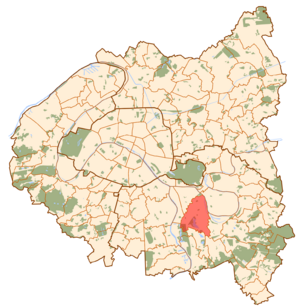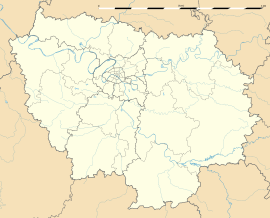Créteil facts for kids
Quick facts for kids
Créteil
|
||
|---|---|---|
|
Prefecture and commune
|
||

Aerial view of Créteil
|
||
|
||

Paris and inner ring departments
|
||
| Country | France | |
| Region | Île-de-France | |
| Department | Val-de-Marne | |
| Arrondissement | Créteil | |
| Canton | 2 cantons | |
| Intercommunality | Grand Paris | |
| Area
1
|
11.43 km2 (4.41 sq mi) | |
| Population
(2021)
|
92,989 | |
| • Density | 8,136/km2 (21,071/sq mi) | |
| Time zone | UTC+01:00 (CET) | |
| • Summer (DST) | UTC+02:00 (CEST) | |
| INSEE/Postal code |
94028 /94000
|
|
| Elevation | 31–74 m (102–243 ft) (avg. 63 m or 207 ft) |
|
| 1 French Land Register data, which excludes lakes, ponds, glaciers > 1 km2 (0.386 sq mi or 247 acres) and river estuaries. | ||
Créteil is a city located in the southeastern suburbs of Paris, Île-de-France. It is about 11.7 kilometers (7.3 miles) from the center of Paris. Créteil is the capital city (called a préfecture) of the Val-de-Marne area.
It is also home to a Catholic diocese and one of France's 30 académies. These are special districts for the Ministry of National Education.
Contents
What's in a Name?
The name Créteil was first written down as Cristoilum in the year 865. This was in a book by a monk named Usuard.
The name Cristoilum comes from a Celtic word, ialo. This word means "clearing" or "open space." It was added to an older word, crist-, whose meaning is not fully clear.
Some people think crist is a Celtic word for "ridge" or "crest." If so, Cristoilum would mean "clearing on the ridge." Another idea is that crist refers to Jesus Christ. This is because Christianity was present in Créteil very early on.
Where is Créteil?
Créteil is in the southeastern suburbs of Paris. The Marne river flows through it. The river makes its last big curve here before joining the Seine river.
The land around Créteil is a flat area. It was shaped by the Marne and Seine rivers over time. Neighboring towns include Maisons-Alfort, Saint-Maur-des-Fossés, and Choisy-le-Roi.
Weather in Créteil
Créteil has a mild climate. This means there are not huge differences between the highest and lowest temperatures. It also gets enough rain all year round. This type of weather is called a marine west coast climate.
A Look Back in Time
Very old tools made of flint have been found in Créteil. These tools are from the Palaeolithic Age, a very early period of human history. A large, two-ton stone tool from the Neolithic Age (New Stone Age) is also a special find from Créteil.
The first records of Créteil are from the Merovingian era. Back then, it was known as Vicus Cristoilum. The name comes from the words crist and oilum. These are believed to be Gallic words. Oilum means "clearing," and crist means "ridge."
The "clearing" on the "ridge" of Mont-Mesly was on an important road. This road connected Paris and Sens. The name "Créteil" appeared in 1406. It changed over time from names like Cristoill and Creteuil.
During the French Wars of Religion in 1567, the Huguenots damaged the local church. They also burned important local documents. More problems in 1648 forced people to leave Créteil.
A very cold winter in 1709 caused a big food shortage in France. In Créteil, 69 people died that winter. Records from the French Revolution in 1789 mention Créteil 15 times.
In the early 18th century, the first middle-class houses were built. In 1814, Russian soldiers took control of eastern Créteil. This was part of the Battle of Paris. A bridge over the Marne river was opened in 1841. It connected Créteil and Saint-Maur-des-Fossés.
The Franco-Prussian War in 1870 was very hard on Créteil. The town was damaged and left in ruins by the Prussians. A battle nearby, at Mont-Mesly, killed 179 people on November 30, 1870.
The Abbaye de Créteil was an artistic group formed in 1906. They were named after a nearby abbey. The group included artists and writers. They were interested in Symbolist and Futurist ideas. Famous people like Filippo Tommaso Marinetti and Constantin Brâncuși were linked to them. The group broke up by 1908.
After World War II, Créteil changed a lot. It became less like a countryside area. The number of people living there grew quickly. In 1965, Créteil became the capital (Préfecture) of the new Val-de-Marne area.
Créteil Lake
Créteil Lake started as a quarry. People dug out gypsum and gravel there. When they dug deep enough, they hit groundwater. This created deep ponds.
The quarry was then left alone and filled with water. Today, the lake is a popular spot for fun activities. People go there for fishing, boating, and windsurfing.
Population Information
How Many People Live Here?
| Historical population | |||||||||||||||||||||||||||||||||||||||||||||||||||||||||||||||||||||||||||||||||||||||||||||||||||||||||||||||||||
|---|---|---|---|---|---|---|---|---|---|---|---|---|---|---|---|---|---|---|---|---|---|---|---|---|---|---|---|---|---|---|---|---|---|---|---|---|---|---|---|---|---|---|---|---|---|---|---|---|---|---|---|---|---|---|---|---|---|---|---|---|---|---|---|---|---|---|---|---|---|---|---|---|---|---|---|---|---|---|---|---|---|---|---|---|---|---|---|---|---|---|---|---|---|---|---|---|---|---|---|---|---|---|---|---|---|---|---|---|---|---|---|---|---|---|---|
|
|
||||||||||||||||||||||||||||||||||||||||||||||||||||||||||||||||||||||||||||||||||||||||||||||||||||||||||||||||||
| Source: EHESS and INSEE (1968-2017) | |||||||||||||||||||||||||||||||||||||||||||||||||||||||||||||||||||||||||||||||||||||||||||||||||||||||||||||||||||
People from Other Places
| Born in metropolitan France | Born outside metropolitan France | |||
|---|---|---|---|---|
| 73.6% | 26.4% | |||
| Born in overseas France |
Born in foreign countries with French citizenship at birth1 | EU-15 immigrants2 | Non-EU-15 immigrants | |
| 3.9% | 4.8% | 2.2% | 15.5% | |
| 1 This group is made up largely of former French settlers, such as pieds-noirs in Northwest Africa, followed by former colonial citizens who had French citizenship at birth (such as was often the case for the native elite in French colonies), as well as to a lesser extent foreign-born children of French expatriates. A foreign country is understood as a country not part of France in 1999, so a person born for example in 1950 in Algeria, when Algeria was an integral part of France, is nonetheless listed as a person born in a foreign country in French statistics. 2 An immigrant is a person born in a foreign country not having French citizenship at birth. An immigrant may have acquired French citizenship since moving to France, but is still considered an immigrant in French statistics. On the other hand, persons born in France with foreign citizenship (the children of immigrants) are not listed as immigrants. |
||||
Schools and Learning
Créteil has many schools for different ages.
Primary and Secondary Schools
Public schools include:
- 24 preschools
- 24 elementary schools
- Eight junior high schools, such as Clément Guyard and Victor Hugo
- Four high schools, including Lycée Léon Blum and Lycée Édouard Branly
Private schools include:
- Ozar HaTorah (a Jewish school with all levels)
- De Maillé (elementary and junior high)
- Lycée général et technologique de l'ensemble Sainte-Marie
- Lycée d'enseignement supérieur technique privé SUPTEK
Universities
Créteil is home to Paris 12 Val de Marne University. It was started in 1970. More than 30,000 students attend this university. It has seven main study areas. These include law, medicine, and business.
Getting Around Créteil
Créteil is connected by the Paris Métro Line 8. There are four metro stations in the city:
- Créteil–L'Échat
- Créteil–Université
- Créteil–Préfecture
- Pointe du Lac
Sports in Créteil
Créteil has a football (soccer) club called US Créteil-Lusitanos. It was founded in 1936. They play their games at the Stade Dominique Duvauchelle.
The city also has a team handball team, US Créteil Handball. They play at the Palais des Sports Robert Oubron. This arena can hold 2,500 people.
Famous People from Créteil
- Jordan Aboki, basketball player
- Mathieu Bastareaud, rugby player
- Eddy de Pretto, singer
- Mohamed Diamé, footballer
- Sylviane Félix, athlete
- Floris Osmond, metallurgist
- Marc Raquil, athlete
- Christopher Samba, footballer
- Camille Serme, squash player
- Dan-Axel Zagadou, footballer
Partner Cities
Créteil has special partnerships with other cities around the world. These are called twin towns or sister cities:
 Les Abymes, Guadeloupe, France
Les Abymes, Guadeloupe, France Falkirk, Scotland, United Kingdom
Falkirk, Scotland, United Kingdom Gyumri, Armenia
Gyumri, Armenia Kiryat Yam, Israel
Kiryat Yam, Israel Mataró, Spain
Mataró, Spain Loulé, Portugal
Loulé, Portugal Playa (Havana), Cuba
Playa (Havana), Cuba Salzgitter, Germany
Salzgitter, Germany
See also
 In Spanish: Créteil para niños
In Spanish: Créteil para niños






